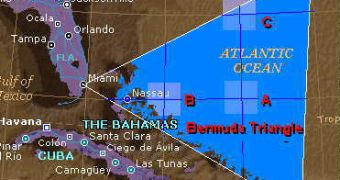The Bermuda Triangle turned famous because of the publicity made around the disappearance of sea and aerial ships recorded in an area of the Atlantic Ocean, the Sargasso Sea, located east of Florida's shore, including the archipelagos of Bermudas, Bahamas, and the islands of Haiti and Puerto Rico. Many believe the Bermuda Triangle, stretching on an area of hundreds of thousands of square kilometers, is a "death zone", but in reality ships and airplanes pass regularly through the area and nothing happens. The disappearances are extremely irregular, and this complicates the puzzle.
The Bermuda islands are located in the north of the Sargasso Sea, an "underwater forest", encountered by Columbus during his first voyage, located 954 km (600 mi) off the Cape Hatteras (US). The archipelago is made of 360 islands, of which only 20 are inhabited.
Juan Bermudez, a Spanish navigator, discovered them in 1516. In 1609, George Somers visited them on his way to Virginia. His stories about the clime and the landscape of the islands inspired Shakespeare to write the play "The Storm". Mark Twain considered the islands were proper for tired people, because of their cedar forests. The Irish poet Thomas Moore compared the port of Hamilton to a smiling man that receives you with his arms opened. Today, due to the deforestation, most of the original vegetation is gone.
The islands were ignored for long, maybe also because of the abundant reefs that caused many shipwrecks. That's why the Spaniards called them Las Islas de Los Diablos (The Islands of the Devils). Located at the same latitude with Gibraltar Strait, the islands are a crossroad between Europe, Africa, and the Americas.
The population of the islands is made of Whites, Blacks and mulattoes. Due to the mild subtropical clime, they are looked for by tourists.
The Sargasso Sea was once the dread of sail ships. Its northern border could be considered a line going from the Chesapeake Bay to Gibraltar, and the southern limit, a line between Haiti and Dakar (Senegal, Africa). Plato and Aristotle spoke about a wide sea located several days of navigation off the Gibraltar Strait, in whose depths the famous Atlantis had vanished. The Greek philosopher Teofrastus (372-287 BC), in his work "The history of the plants", spoke about the mud and weeds that stuck the ships attempting to cross this sea invaded by grass. The name of the sea comes from the brown alga Sargassum, that form huge floating plant masses, an entire sea ecosystem on its own.
Columbus reached it in 1492. The sea invaded of grass scared his sailors, who wanted to return home. After several days of navigation, they got out of the grassy area into open sea. Nevertheless, the legend of a dreadful sea was born. The story lasted along the centuries, delivering fantastic and provoking subjects for the writers. In the middle of the 19th century, William Robert Chambers described this sea as an enormous graveyard for wrecks of all times and of all sizes.
In 1898, the adventure book of the American writer Thomas Janvier described the mishaps of the sailor Roger. On a raft drifted by very strong currents in the middle of the sea, he saw a piling of ships, on which dead sailors stayed on their posts, and dead slaves were chained. Hence, from translating imagination into reality was just a step.

 14 DAY TRIAL //
14 DAY TRIAL //